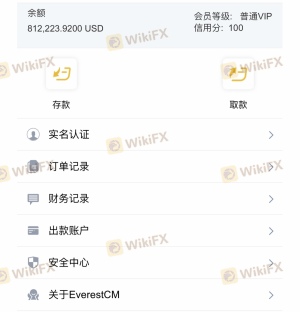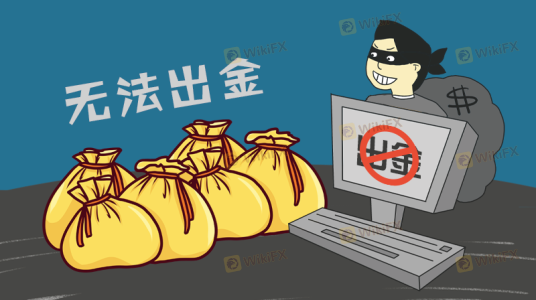Is EVEREST safe?
Rating Index
Pros
Cons
Is Everest Safe or a Scam?
Introduction
Everest, a name that has emerged in the forex trading landscape, claims to offer competitive trading conditions and a wide array of financial instruments. However, as with any trading platform, it is crucial for traders to conduct thorough due diligence before engaging with such brokers. The forex market is rife with potential risks, including fraud and mismanagement, making it essential for investors to assess the legitimacy and safety of the brokers they choose to work with. This article aims to provide an objective analysis of Everest's safety and reliability, utilizing various sources and data points to evaluate its regulatory status, company background, trading conditions, and customer experiences.
Regulation and Legitimacy
The regulatory status of a broker is one of the most critical factors that determine its safety. Everest does not appear to be regulated by any reputable financial authority, which raises significant concerns regarding its legitimacy. Below is a summary of the regulatory information:
| Regulatory Authority | License Number | Regulatory Region | Verification Status |
|---|---|---|---|
| None | N/A | N/A | Unverified |
The absence of regulation means that Everest does not adhere to the strict standards set by financial authorities, which typically include capital requirements, regular audits, and investor protection mechanisms. This lack of oversight can expose traders to various risks, including the potential for fraud and the inability to recover funds in case of disputes. Furthermore, past compliance issues have been noted, indicating a troubling history that could further jeopardize investor safety.
Company Background Investigation
Everest's company history reveals a relatively recent establishment in the forex trading space, with limited transparency regarding its ownership structure and management team. The lack of publicly available information about the company's founders and executives raises red flags about its operational integrity. A thorough analysis of the management team's background is essential, as experienced and reputable leadership can often be a reassuring indicator of a broker's reliability.
Transparency in operations is vital for any financial institution, particularly in the forex sector, where trust is paramount. Everest's failure to provide clear information about its corporate structure and management team contributes to skepticism regarding its trustworthiness. Without a solid foundation of transparency, potential clients may find it challenging to gauge the broker's commitment to ethical practices and investor protection.
Trading Conditions Analysis
When evaluating a broker like Everest, understanding its fee structure and trading conditions is crucial. Everest claims to offer competitive spreads and favorable trading conditions; however, the absence of clear information about its fee structure can lead to confusion for potential clients. Below is a comparative overview of Everest's trading costs:
| Fee Type | Everest | Industry Average |
|---|---|---|
| Major Currency Pair Spread | From 0.8 pips | From 1.0 pips |
| Commission Model | Variable | Generally fixed |
| Overnight Interest Range | Varies | Varies |
The potential for hidden fees, such as high withdrawal charges or inactivity fees, remains a concern. Clients should be wary of any unusual or excessive fees that could diminish their trading profits. A clear and straightforward fee structure is essential for building trust and ensuring that traders are aware of all costs associated with their trading activities.
Customer Funds Safety
The safety of customer funds is paramount when selecting a broker. Everest's policies regarding fund safety are crucial to evaluate. The broker claims to implement measures for fund segregation and negative balance protection; however, without regulatory oversight, the effectiveness of these measures is questionable. Historical issues related to fund security have been reported, which could indicate a lack of adequate protections for client investments.
Traders should be particularly cautious about brokers that do not segregate client funds from their operational funds, as this practice is essential for safeguarding investor assets. Moreover, the absence of investor compensation schemes further exacerbates the risks associated with trading through Everest.
Customer Experience and Complaints
Customer feedback is an invaluable resource for assessing a broker's reliability. Many reviews of Everest indicate a mix of experiences, with some clients expressing satisfaction with the trading conditions, while others report significant issues, particularly regarding withdrawals. Below is a summary of common complaints associated with Everest:
| Complaint Type | Severity Level | Company Response |
|---|---|---|
| Withdrawal Delays | High | Poor |
| Unclear Fee Structure | Medium | Average |
| Poor Customer Support | High | Poor |
Typical case studies reveal that some clients have faced challenges in withdrawing their funds, leading to frustration and distrust. The company's response to these complaints appears to be inadequate, which only serves to heighten concerns about Everest's commitment to customer service and satisfaction.
Platform and Execution
The trading platform offered by Everest plays a significant role in the overall trading experience. Users have reported mixed reviews regarding the platform's performance, stability, and user interface. Essential aspects such as order execution quality, slippage rates, and the incidence of order rejections are critical factors that can impact a trader's profitability.
While Everest claims to provide a robust trading platform, any signs of manipulation or technical issues could further undermine trust in the broker. Ensuring a seamless trading experience is vital for traders, particularly in the fast-paced forex market.
Risk Assessment
Engaging with a broker like Everest involves various risks that potential clients should be aware of. Below is a risk assessment summary:
| Risk Category | Risk Level (Low/Medium/High) | Brief Explanation |
|---|---|---|
| Regulatory Risk | High | Unregulated status increases potential for fraud. |
| Fund Safety Risk | High | Lack of investor protection mechanisms. |
| Operational Risk | Medium | Mixed reviews regarding platform reliability. |
To mitigate these risks, traders should consider using only well-regulated brokers with a proven track record of reliability and customer service. Conducting thorough research and seeking out alternative options can help ensure a safer trading environment.
Conclusion and Recommendations
In conclusion, the evidence suggests that Everest poses significant risks for potential investors. The lack of regulation, questionable fund safety measures, and a history of customer complaints raise red flags about its legitimacy. Traders should exercise caution and consider alternative brokers that offer robust regulatory oversight and transparent operations.
For those seeking reliable trading options, it is advisable to explore brokers that are regulated by reputable authorities such as the FCA, ASIC, or CySEC. These brokers typically offer better protection for investor funds and a higher level of operational transparency. Ultimately, the question remains: Is Everest safe? The overwhelming consensus is that potential clients should proceed with caution and prioritize their financial security by choosing well-regulated alternatives.
Is EVEREST a scam, or is it legit?
The latest exposure and evaluation content of EVEREST brokers.


EVEREST Similar Brokers Safe
Whether it is a legitimate broker to see if the market is regulated; start investing in Forex App whether it is safe or a scam, check whether there is a license.
EVEREST latest industry rating score is 1.48, the higher the score the safer it is out of 10, the more regulatory licenses the more legitimate it is. 1.48 If the score is too low, there is a risk of being scammed, please pay attention to the choice to avoid.
